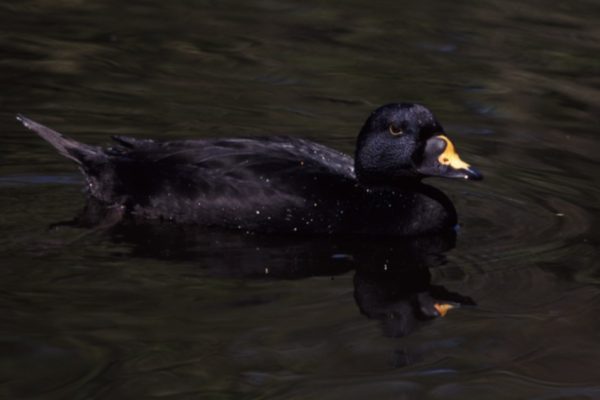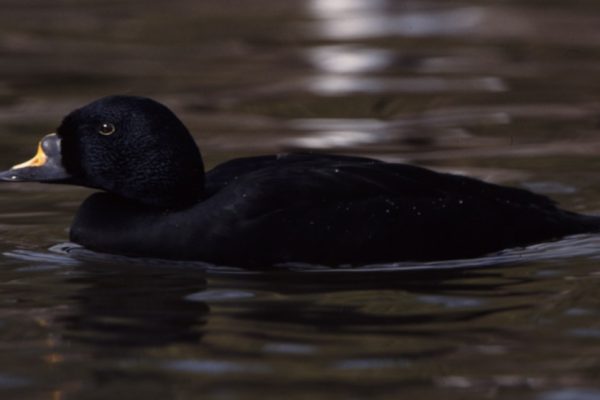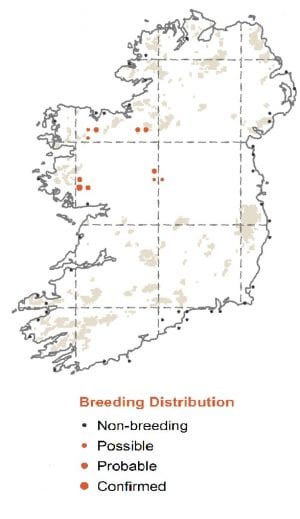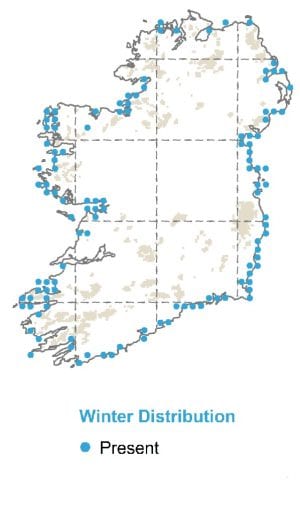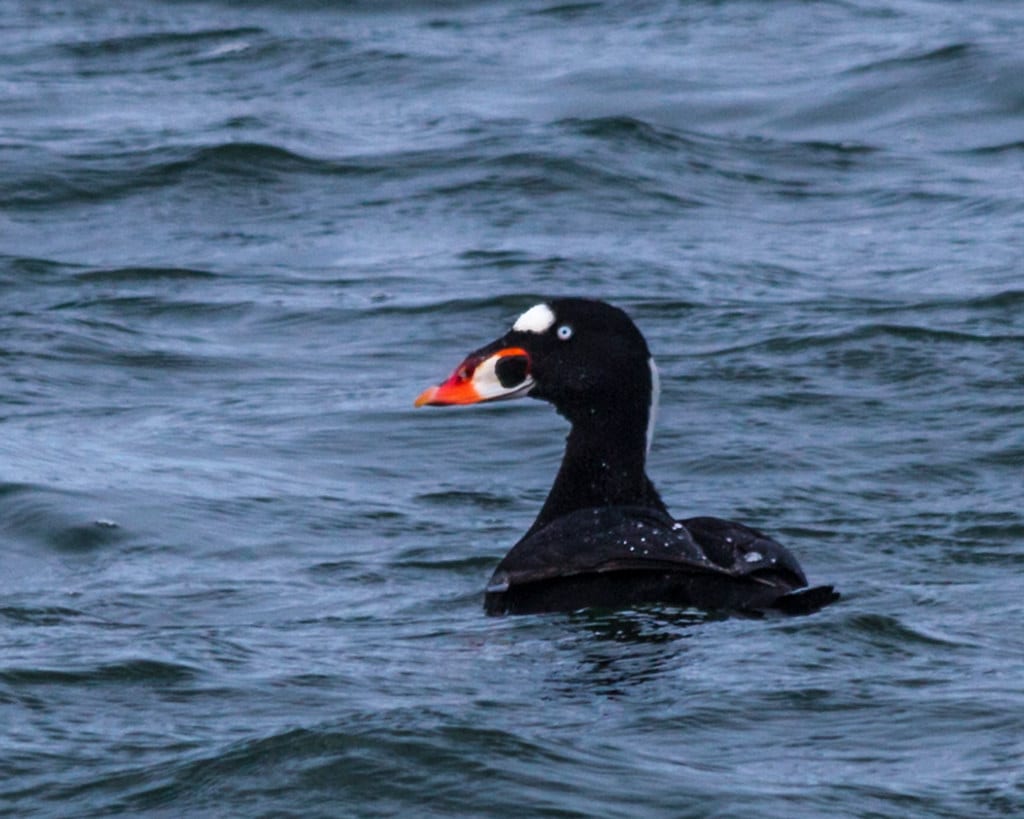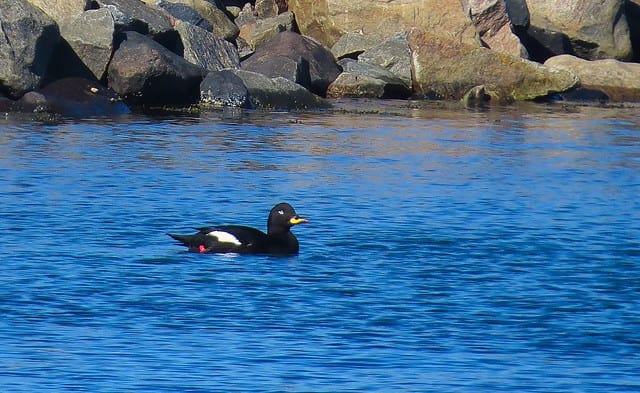
Common Scoter
| Irish Name: | Scótar |
| Scientific name: | Melanitta nigra |
| Bird Family: | Ducks |
red
Conservation status
Conservation status
Status
Resident and winter visitor from the Continent to all Irish coasts between October and April.
Identification
Medium-sized, plump duck usually seen in large flocks offshore. At closer range, males with yellow knob at base of bill. All dark plumage, with no white on the wing. Males black, females sooty brown with paler cheeks.
Voice
Soft piping 'pju'.
Diet
During the summer the diet is varied and includes water plants, insect larvae and freshwater crustaceans. During the winter, they forage mostly in waters less than 20 m deep and with coarse sandy substrates. They feed predominantly on benthic bivalve molluscs.
Breeding
First recorded breeding in Ireland in the beginning of the 20th century at Lower Lough Erne. Numbers increased steadily - up to 150 pairs were estimated during the late 1960s. They nest on islands with dense covering of scrub and tree cover. The breeding population has declined since due to the increase in Mink, which predate the nests and young.
Wintering
Common Scoter are almost entirely marine during the winter, and tend to congregate in large flocks on shallow seas with sandy bottoms supporting their preferred prey.
Monitored by
Blog posts about this bird

New protected area off Wexford coast is a step forward for vulnerable seabirds
The recent announcement of the new “Seas off Wexford” Special Protection Area (SPA) is certainly news to be welcomed.
For such a designation to be as effective as it can be, it is crucial that strong and effective conservation objectives and management plans are ambitious and that stakeholders are consulted throughout the process. It would be most welcome if the designation of new marine SPAs also led to a new vision for management of Ireland’s entire network of SPAs. BirdWatch Ireland calls on government to ensure that management plans are put in place for SPAs on both land and sea and that a whole-of-government approach is taken to implement them properly to safeguard the future of the birds they are intended to protect.
Minister for Housing, Local Government and Heritage Darragh O’Brien recently designated the new SPA of marine waters off the coast of Wexford which, at over 305,000 hectares, is the largest SPA designated in the history of the state. These waters provide extremely important food sources for seabirds, including Red-listed species such as Puffin, Kittiwake, Common Scoter and many other vulnerable Amber-listed species such as Fulmar, Manx Shearwater, Shag, Cormorant, Black-headed Gull, Lesser Black-backed Gull, Herring Gull, Roseate Tern, Red-throated Diver, Gannet, Common Tern, Little Tern, Sandwich Tern, Mediterranean Gull and Guillemot.



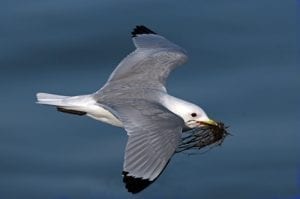
Kittiwake. Photo: Colum Clarke.
Under EU legislation, the Irish government has made a commitment to designate 10% of its waters as protected by 2025, and a total of 30% by 2030. This new designation increases the percentage of Ireland’s marine protected waters to 9.4%, just under the 2025 target. While this is certainly a step in the right direction, many questions remain, primarily, what will “protection” look like in practice? It is paramount that this is made clear in the soon-to-be-published SPA’s conservation objectives, which should detail the activities that will and will not be permitted in the SPA, among other measures. We look forward to reading them shortly. At the same time, BirdWatch Ireland in collaboration with BirdLife Europe and BirdLife International are mapping Ireland’s marine Important Bird Areas according to international and standardised BirdLife International criteria under a project funded by the Flotilla Foundation. This is an important time for our seabirds and it is welcome to see the government’s focus finally on setting out protected areas for them.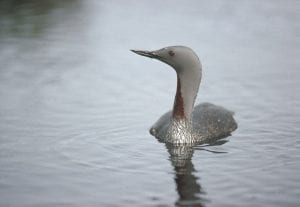
Red-throated Diver. Photo: Chris Gomersall
While the finer details about the Wexford SPA have yet to come to light, it is clear that certain activities will not be permitted in the Wexford SPA. The Minister has issued a Direction in relation to certain activities, which must not be carried out within or close to the SPA, unless consent is lawfully given. The listed activities are reclamation including infilling; blasting, drilling, dredging or otherwise disturbing or removing fossils, rock, minerals, mud, sand, gravel or other sediment; introduction or reintroduction of plants or animals not found in the area; scientific research which involves the removal of biological material; any activity intended to disturb birds; undertaking acoustic surveys in the marine environment and developing or consenting to the development or operation of commercial recreational/ visitor facilities or organised recreational activities.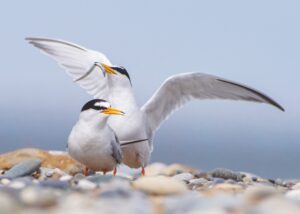
Little Terns.
Together with our partners at Fair Seas – a coalition of Ireland’s leading environmental NGOs and environmental networks of which BirdWatch Ireland is a founding member – we have been calling for the government to meet their targets, but this alone is not enough. More action must be taken in order for us to adequately protect these important marine habitats and the many species that they support. Any move to better protect important habitats for birds is to be welcomed, and this is certainly no different. We are urging the Irish government to be ambitious in their plans for this new SPA and stress the need for focused community engagement in the surrounding areas. We also continue our urgent calls for the publication of the long-awaited Marine Protected Areas (MPA) Bill.
BirdWatch Ireland Celebrates 50th Anniversary
[vc_row type="in_container" full_screen_row_position="middle" scene_position="center" text_color="dark" text_align="left" overlay_strength="0.3" shape_divider_position="bottom"][vc_column column_padding="no-extra-padding" column_padding_position="all" background_color_opacity="1" background_hover_color_opacity="1" column_link_target="_self" column_shadow="none" column_border_radius="none" width="1/1" tablet_width_inherit="default" tablet_text_alignment="default" phone_text_alignment="default" column_border_width="none" column_border_style="solid"][vc_column_text]Initially set up as the Irish Wild Bird Conservancy or IWC in 1968. BirdWatch Ireland as it is now known has gone from strength to strength over it's 50 years in existence. BirdWatch Ireland is now Ireland's largest independant wildlife conservation organisation, annually carrying out vitally important works for protecting birds and biodiversity (which just so happens to be our motto). This work includes; surveys and monitoring of birds and their habitats, so we can keep a finger on the pulse of wildbird populations and implement protective measures if these populations are negatively impacted by anthropogenic or other negative factors. In addition, the important policy and advocacy work we carry out around the clock means that Irish wildlife has the strongest possible voice in the halls of power across Ireland and indeed Europe. Explore our website and find out more about some of this critical ongoing work. To ensure the protection of our wildlife for future generations it is imperative to provide education for the next generation of wildlife lovers.
In achieving this we have collaborated with our European BirdLife partners to produce teacher training resources and subsequently delivered this material through teacher training workshops. BirdWatch Ireland acts as a unified voice for the concerns of our passionate and dedicated wildlife supporters, without whom the organisation would certainly not be in the respected position it is today. On the occassion of BirdWatch Irelands 50th Anniversary, everyone in the organisation would like to say a very special thank you to our members and supporters. If you are not already involved with BirdWatch Ireland Click the Become A Member tab and make a difference for your wildlife today. Here's to another 50 years protecting Ireland's Birds and Biodiversity.
Read More in Wings about the Roots of BirdWatch Ireland:[/vc_column_text][/vc_column][/vc_row][vc_row type="in_container" full_screen_row_position="middle" scene_position="center" text_color="dark" text_align="left" overlay_strength="0.3" shape_divider_position="bottom"][vc_column column_padding="no-extra-padding" column_padding_position="all" background_color_opacity="1" background_hover_color_opacity="1" column_link_target="_self" column_shadow="none" column_border_radius="none" width="1/1" tablet_width_inherit="default" tablet_text_alignment="default" phone_text_alignment="default" column_border_width="none" column_border_style="solid"][vc_column_text][birdwatch-publication-list filters='false' number-posts='false' ids='6611'][/vc_column_text][/vc_column][/vc_row][vc_row type="full_width_background" full_screen_row_position="middle" bg_image="5020" bg_position="center top" bg_repeat="no-repeat" parallax_bg="true" parallax_bg_speed="fast" bg_color="#f7f7f7" scene_position="center" text_color="light" text_align="left" top_padding="85" bottom_padding="90" overlay_strength="0.3" shape_divider_position="bottom" shape_type=""][vc_column enable_animation="true" animation="fade-in-from-bottom" column_padding="padding-1-percent" column_padding_position="all" background_color_opacity="1" background_hover_color_opacity="1" column_link_target="_self" column_shadow="none" column_border_radius="none" width="1/2" tablet_width_inherit="default" tablet_text_alignment="default" phone_text_alignment="default" column_border_width="none" column_border_style="solid"][vc_column_text css=".vc_custom_1556289037459{margin-bottom: 50px !important;}" el_class="title-line"]

